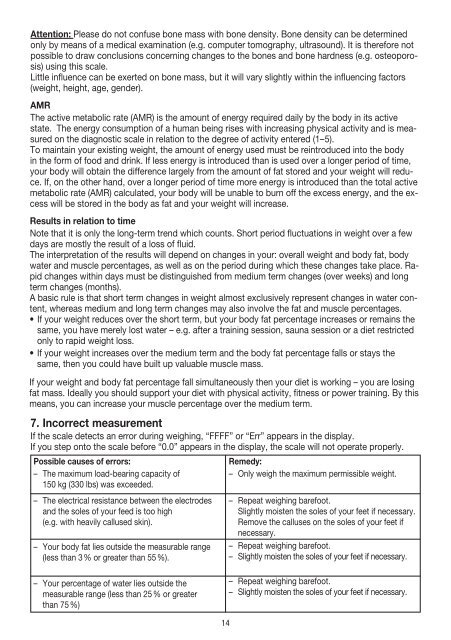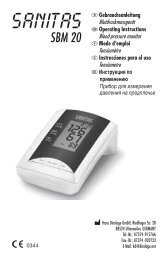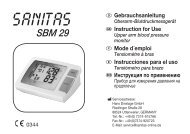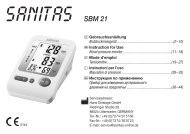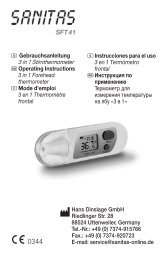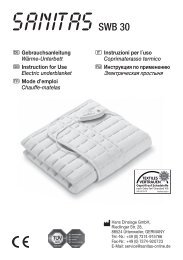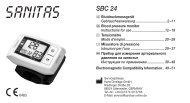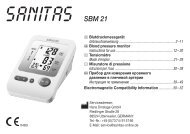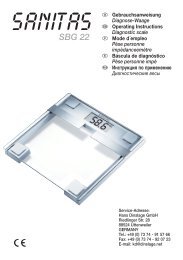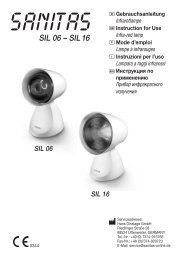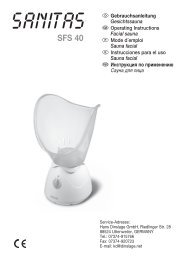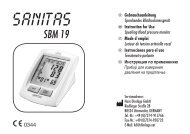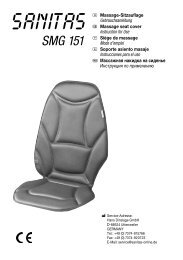SBG 39 - Sanitas
SBG 39 - Sanitas
SBG 39 - Sanitas
You also want an ePaper? Increase the reach of your titles
YUMPU automatically turns print PDFs into web optimized ePapers that Google loves.
Attention: Please do not confuse bone mass with bone density. Bone density can be determined<br />
only by means of a medical examination (e.g. computer tomography, ultrasound). It is therefore not<br />
possible to draw conclusions concerning changes to the bones and bone hardness (e.g. osteoporosis)<br />
using this scale.<br />
Little influence can be exerted on bone mass, but it will vary slightly within the influencing factors<br />
(weight, height, age, gender).<br />
AMR<br />
The active metabolic rate (AMR) is the amount of energy required daily by the body in its active<br />
state. The energy consumption of a human being rises with increasing physical activity and is measured<br />
on the diagnostic scale in relation to the degree of activity entered (1– 5).<br />
To maintain your existing weight, the amount of energy used must be reintroduced into the body<br />
in the form of food and drink. If less energy is introduced than is used over a longer period of time,<br />
your body will obtain the difference largely from the amount of fat stored and your weight will reduce.<br />
If, on the other hand, over a longer period of time more energy is introduced than the total active<br />
metabolic rate (AMR) calculated, your body will be unable to burn off the excess energy, and the excess<br />
will be stored in the body as fat and your weight will increase.<br />
Results in relation to time<br />
Note that it is only the long-term trend which counts. Short period fluctuations in weight over a few<br />
days are mostly the result of a loss of fluid.<br />
The interpretation of the results will depend on changes in your: overall weight and body fat, body<br />
water and muscle percentages, as well as on the period during which these changes take place. Rapid<br />
changes within days must be distinguished from medium term changes (over weeks) and long<br />
term changes (months).<br />
A basic rule is that short term changes in weight almost exclusively represent changes in water content,<br />
whereas medium and long term changes may also involve the fat and muscle percentages.<br />
• If your weight reduces over the short term, but your body fat percentage increases or remains the<br />
same, you have merely lost water – e.g. after a training session, sauna session or a diet restricted<br />
only to rapid weight loss.<br />
• If your weight increases over the medium term and the body fat percentage falls or stays the<br />
same, then you could have built up valuable muscle mass.<br />
If your weight and body fat percentage fall simultaneously then your diet is working – you are losing<br />
fat mass. Ideally you should support your diet with physical activity, fitness or power training. By this<br />
means, you can increase your muscle percentage over the medium term.<br />
7. Incorrect measurement<br />
If the scale detects an error during weighing, “FFFF” or “Err” appears in the display.<br />
If you step onto the scale before “0.0” appears in the display, the scale will not operate properly.<br />
Possible causes of errors:<br />
– The maximum load-bearing capacity of<br />
150 kg (330 lbs) was exceeded.<br />
– The electrical resistance between the electrodes<br />
and the soles of your feed is too high<br />
(e.g. with heavily callused skin).<br />
– Your body fat lies outside the measurable range<br />
(less than 3 % or greater than 55 %).<br />
Remedy:<br />
– Only weigh the maximum permissible weight.<br />
– Repeat weighing barefoot.<br />
Slightly moisten the soles of your feet if necessary.<br />
Remove the calluses on the soles of your feet if<br />
necessary.<br />
– Repeat weighing barefoot.<br />
– Slightly moisten the soles of your feet if necessary.<br />
– Your percentage of water lies outside the<br />
measurable range (less than 25 % or greater<br />
than 75 %)<br />
– Repeat weighing barefoot.<br />
– Slightly moisten the soles of your feet if necessary.<br />
14


